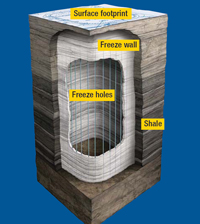|
Vol. 231 No. 9 |

|
|
HENRY TERRELL, CONTRIBUTING NEWS EDITOR
|
Oil shale—a peak at future technology
The untimely passing of Matt Simmons last month brought an end to one of the most original and controversial energy “insiders” (see “Innovative thinkers,” p. 21). Simmons, a regular contributor to this magazine since the early 1990s, did not coin the term “peak oil”—that distinction goes to visionary geologist M. King Hubbert—but he brought the expression back into the journalistic mainstream. It is a subject that certainly elicits passion, but it is not controversial on its face—there is a finite time in the future (past?) when world oil production peaks. The only questions are when and how rapid the decline will be.
Since we have, and will continue to have, a petroleum-based civilization, demand will invariably rise, as will prices. Mature oil from shale is commercially attractive at today’s prices using today’s technology. Oil shale, inorganic rock embedded with immature deposits of hydrocarbons, is a tougher nut to crack, but will someday prove both economical and irresistible. When it does, the technology to extract it efficiently had better be there, because it’s coming out of the ground anyway, either as mined and cooked rock, or by some more exotic, in situ method.
Retorted. Last month (see World Oil, August 2010, p. 19), Pramod Kulkarni discussed some of the history behind attempts to commercialize oil from oil shale (a misleading term, since the organic material isn’t technically crude oil, and the rock isn’t necessarily shale). The most ambitious plan to utilize oil shale was the Colony Development joint venture project in the Green River Formation of northwestern Colorado, begun in 1964.
Exxon bought a controlling interest in 1980, during the second oil-price shock, and planned to invest $5 billion (in 1980 dollars) in the project. It was a full-on frontal assault. A commercial-scale plant was begun, with the intention of employing a “rotating retort” process to extract oil from the shale using six enormous surface mines. The plan was to process thousands of tons of shale per day to produce about 47,000 bopd. Optimists predicted that by 2010 as much as 8 million bopd could be coming from the region.
Of course, favorable price conditions rapidly fell apart. After peaking in December 1979, crude prices fell six straight years, and Exxon pulled the plug on the Colony in 1982, writing off over a billion dollars. In its abbreviated life, the project produced 270,000 bbl of oil. Exxon’s exit from the scene made the entire industry oil-shale shy.
Recently, however, research has continued, spurred by enormous potential and a whole new round of price spikes. In 2005, the Bureau of Land Management (BLM) received 20 proposals for R&D programs to recover oil shale hydrocarbons from leased public lands. Each nomination was judged on its potential to advance the technology, its economic viability and potential environmental effects. Six of these were accepted.
CRUSHed. One such proof-of-concept program is being developed by Chevron, in conjuction with the Los Alamos National Laboratory. The Chevron Recovery and Upgrading of Oil from Shale technology, or CRUSH (almost), involves the injection of heated CO2-rich gases into a horizontally fractured formation. The hot CO2 circulates through the fractured formation to another vertical well and to the surface to be reheated and reinjected. This heats the formation very slowly to the temperature where kerogen decomposes, at which point the gases, oil and water are recovered and separated.
 |
Fig. 1. Shell’s freeze wall test uses an array of wells containing refrigerant to create a frozen barrier. Courtesy of Shell.
|
|
In the next phase, air forced into the formation causes the kerogen left behind in previously depleted zones to combust in situ and generate the heated gases required to produce from other intervals. These gases would be forced from the depleted zone into a newly fractured part of the formation and the process would repeat, decomposing kerogen into producible oil and gas until, ideally, 90% of hydrocarbons in place are recovered.
Isolated. To meet the goals of the third (environmental) criterion, care is taken to avoid permanently altering the land surface and protect surface water quality. Of greater importance, however, is the potential effect production could have on groundwater.
Fortunately (from an environmental standpoint), the oil-rich interval, the Mahogany zone, is relatively impermeable and is expected to act as a confining layer to prevent contact with aquifers above and below it. Wells drilled through the upper aquifer will utilize casing designed to prevent contact between production fluids and groundwater. The horizontal fractures of the formation should not extend into the lower aquifer. In case of natural vertical fractures, cements and polymers could be used to isolate the so-called “rubblized” zone from the aquifers. Groundwater would be monitored through an array of wells.
Frozen. For Shell’s Mahogany research project, another in-ground retort process discussed in this column last month, protection of groundwater is to be achieved through an underground barrier called a “freeze wall.” This is made by drilling a series of wells around the extraction zone and pumping in refrigerated fluid, creating an impermeable wall of ice. Similar techniques have been used in mining and construction industries for decades. The Shell freeze wall test began in 2007 and continues today. To test the concept, Shell drilled 157 holes about 1,800 ft deep and spaced 8 ft apart to create a closed-loop pipe system, and then circulated ammonia as a refrigerant. The resulting wall takes about 18 months to freeze and is about 30 ft thick. Final testing includes deliberate attempts to breach the barrier with air and water pressure. 
|




